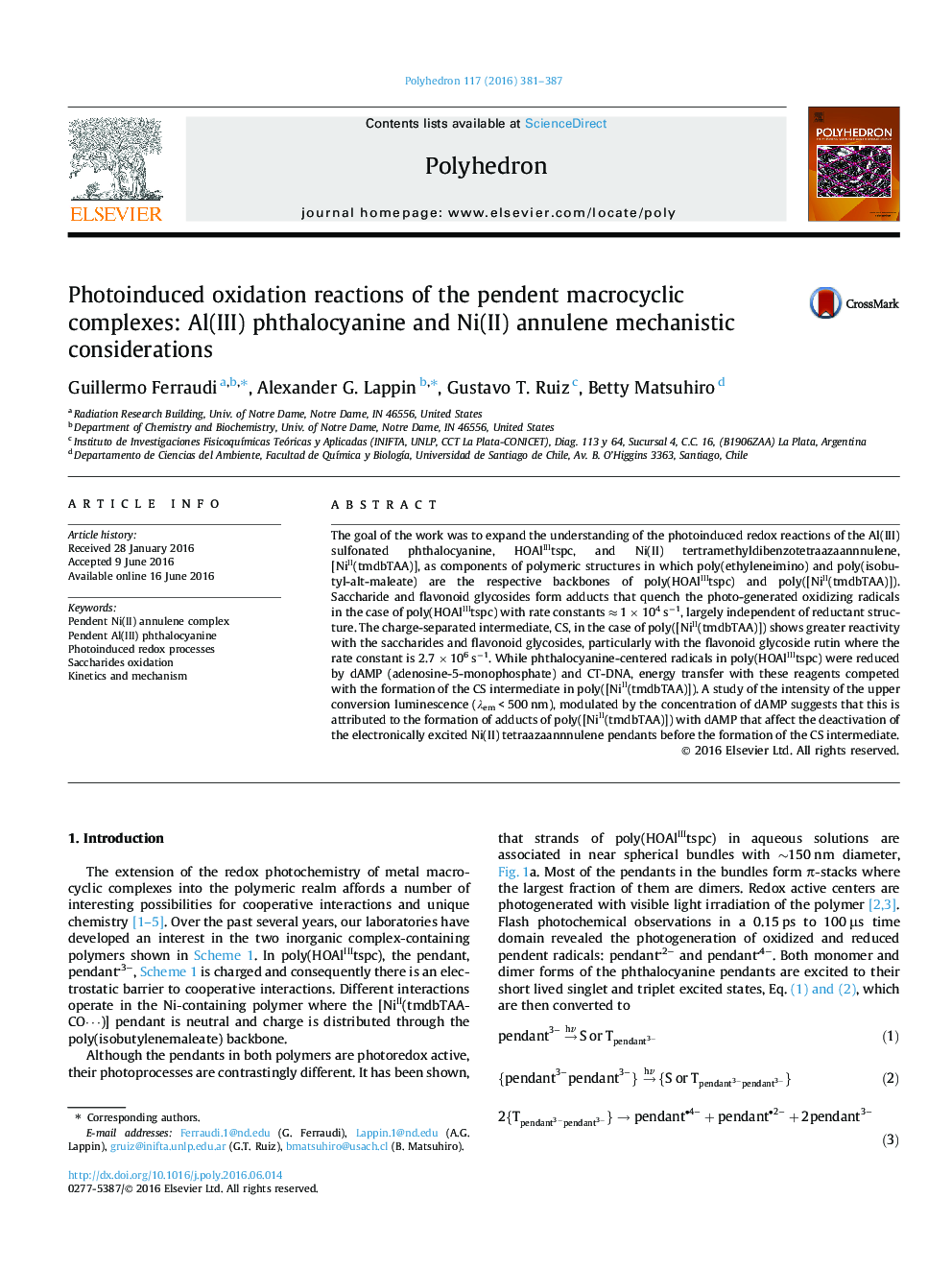| کد مقاله | کد نشریه | سال انتشار | مقاله انگلیسی | نسخه تمام متن |
|---|---|---|---|---|
| 1336219 | 1500223 | 2016 | 7 صفحه PDF | دانلود رایگان |

The goal of the work was to expand the understanding of the photoinduced redox reactions of the Al(III) sulfonated phthalocyanine, HOAlIIItspc, and Ni(II) tertramethyldibenzotetraazaannnulene, [NiII(tmdbTAA)], as components of polymeric structures in which poly(ethyleneimino) and poly(isobutyl-alt-maleate) are the respective backbones of poly(HOAlIIItspc) and poly([NiII(tmdbTAA)]). Saccharide and flavonoid glycosides form adducts that quench the photo-generated oxidizing radicals in the case of poly(HOAlIIItspc) with rate constants ≈ 1 × 104 s−1, largely independent of reductant structure. The charge-separated intermediate, CS, in the case of poly([NiII(tmdbTAA)]) shows greater reactivity with the saccharides and flavonoid glycosides, particularly with the flavonoid glycoside rutin where the rate constant is 2.7 × 106 s−1. While phthalocyanine-centered radicals in poly(HOAlIIItspc) were reduced by dAMP (adenosine-5-monophosphate) and CT-DNA, energy transfer with these reagents competed with the formation of the CS intermediate in poly([NiII(tmdbTAA)]). A study of the intensity of the upper conversion luminescence (λem < 500 nm), modulated by the concentration of dAMP suggests that this is attributed to the formation of adducts of poly([NiII(tmdbTAA)]) with dAMP that affect the deactivation of the electronically excited Ni(II) tetraazaannnulene pendants before the formation of the CS intermediate.
The photoinduced redox reactions of the Al(III) sulfonated phthalocyanine, HOAlIIItspc, and Ni(II) tertramethyldibenzotetraazaannnulene, [NiII(tmdbTAA)], grafted into polymeric structures were investigated in this work. Poly(ethyleneimino) and poly(isobutyl-alt-maleate) were the respective backbones of poly(HOAlIIItspc) and poly([NiII(tmdbTAA)]). Saccharide and flavonoid glycosides were used as probes of the reactions of radicals generated in the case of poly(HOAlIIItspc), or the charge-separated intermediate, CS, in the case of poly([NiII(tmdbTAA)]). While the phthalocyanine-centered radicals were reduced by saccharide, flavonoid glycosides, dAMP (adenosine-5-monophosphate) and CT-DNA, only saccharide and flavonoid glycosides reduced the CS intermediate. In addition to the failure of the CS intermediate to oxidize CT-DNA and dAMP, the intensity of the upper conversion luminescence (λem < 500 nm), is modulated by the concentration of dAMP. The modulation is attributed to the formation of adducts of poly([NiII(tmdbTAA)]) with dAMP which affect the deactivation of the electronically excited Ni(II) tetraazaannnulene pendants before the formation of the CS intermediate. Specific rate constants of the various processes were determined and their values were rationalized on the basis of the reactants intrinsic structural features.Figure optionsDownload as PowerPoint slide
Journal: Polyhedron - Volume 117, 15 October 2016, Pages 381–387